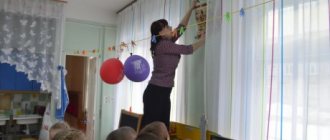Household work: tasks, content, management methods in various age groups
Household work is the second type of labor that a child of preschool age is able to master. The contents of this type of labor are: labor to clean the premises; washing dishes, laundry, etc.
Household work of preschoolers is aimed at maintaining cleanliness and order in the premises and on the site, and helping adults in organizing routine processes. Children learn to notice any disturbance of order in a group room or area and, on their own initiative, eliminate it. Household work is aimed at serving the team and therefore contains great opportunities for developing a caring attitude towards peers.
Tasks and content of work in groups:
1st junior group:
1. Teach children to maintain order in the playroom and, at the end of the games, to place the play material in its place.
2. Involve children in performing simple labor activities. Together with an adult and under his supervision, place bread bins (without bread) and napkin holders on the table before eating.
2nd junior group:
1. Encourage children to independently carry out basic tasks - prepare materials for classes (brushes, modeling boards, etc.); After playing, put away toys and building materials
2. Teach to maintain order and cleanliness in the premises and area of the kindergarten
3. Encourage to provide assistance to adults, to cultivate a caring attitude towards the results of their work.
4. In the second half of the year, begin to develop in children the skills necessary for serving in the dining room: helping to set the table for dinner (laying out spoons and forks, arranging bread bins, plates, cups, etc.).
Middle group
1. Teach children to maintain order in the group and in the kindergarten area: put away building materials, help the teacher, glue books and boxes.
2. Teach children to independently perform the duties of a canteen attendant: carefully arrange bread bins, lay out cutlery (spoons, forks, knives).
Senior group
1. Teach children to help adults maintain order in the group: wipe toys and teaching aids, wash toys and building materials, repair books and toys.
2. To develop the ability to clean up the kindergarten area: sweep and clear paths of debris, snow in winter, water sand in the sandbox
3. Teach children to independently and conscientiously perform the duties of the dining room attendants, to set the table, to clear away the dishes after meals.
4. Learn to independently lay out materials for classes prepared by the teacher, put them away, wash brushes, paint sockets, palettes, and wipe tables.
Preparatory group
1. Continue to teach children to constantly and promptly maintain order in the group and on the site: wipe toys and aids, wash toys, building materials, repair books and toys together with the teacher.
2. Continue to teach how to independently clean up the kindergarten area: sweep and clear paths of debris, snow in winter, water sand in the sandbox.
3. Learn to make your own bed after sleep.
4. Accustom children to independently and conscientiously perform the duties of dining room attendants: setting the table in full, distributing second and third courses (berries, fruits), clearing away dishes after meals, sweeping the floor.
5. Learn to independently lay out materials for classes prepared by the teacher, put them away, wash brushes, paint sockets, and wipe tables.
By the end of the year, children can: organize their workspace and put it in order after classes are over.
Summary of a lesson on household work in the preparatory school group “Household Services”
Summary of a lesson on household work in the preparatory school group “Household Services”
Target:
Formation in children of the simplest labor skills, skills that are manifested in everyday activities.
Tasks:
Educational task
:
To form in children a positive attitude towards work, its results, and a desire to work.
Developmental task:
Promote the development of communication skills through the ability to collaborate in small groups.
Educational task:
To cultivate in children such personality qualities as: independence, accuracy, mutual assistance, caring for each other, responsibility for a common cause.
Equipment:
1.
Application cards with images.
2.
3 basins of water, 5 rags, 2 sponges, 2 brushes, 2 empty basins,
2 trays;
3.
Aprons for all children, 3 pairs of arm sleeves, soap, soap dish,
2 tablecloths
Methods and techniques
:
• Visual - observations, looking at pictures.
• Practical - training in certain methods of performing labor operations ( how to wring out a rag so that water does not flow down the sleeves, etc.).
• Verbal – questions, conversations, use of literary words, directions.
Preliminary work:
Learning proverbs and sayings about work, participating in the game “Household Services”, getting to know professions.
Progress of the lesson:
Stage 1. Work motivation
Guys, you know that there are services that come to help people. What services are these? (Answers).
Well done. And there is a service that provides services to people. This is a household service. What services do you think this service provides? (Washes, washes,...) Yes, this service cleans apartments, washes windows, washes and cleans things. What do welfare workers do? (Help people).
— Guys, did you want to work in the consumer service and help people? Would you like to organize your own household service in our group? In our kindergarten, in our group, who do you think we could help? (To the junior teacher). How can we help Elena Viktorovna?
— Do you know how welfare workers organize their work? (Answers).
Stage 2. Organization of labor activities.
They fulfill requests received from people. Our consumer service also received applications from Elena Viktorovna. To complete these requests, we need to split into 3 teams. Every team must have a captain. Let's choose captains, and they will choose their assistants, who wants to be captain? ( Children choose captains.)
Before we get started, let's take a look and remember our reminders:
1.Don't quarrel;
2. Help each other;
3. If you’ve worked, clean up your place.
(Children tell the rules of behavior during work according to the diagrams).
- Guys, don’t forget that when you work, you need to be polite. And so, let's start cleaning. Don't forget to wear aprons to avoid getting your clothes wet.
Captains, pull out job applications for yourself. Approach your teams and discuss together what do you need to do your job? ( Discussion in progress).
- Which team will work here and repair our books? First we need to measure a strip of the required length. To do this, you place the strip in front of you, place the book on the strip with the spine facing you .
Align the spine of the book and the edge of the strip well
.
Make a mark with a pencil, then cut along the mark line.
First bend this strip in half, ironing the fold well, and then straighten it again, apply glue to the lining. Place the book with the spine on the strip so that the pages are facing you .
Place the book up to the fold of your strip, then fold the other half of the strip and glue it to it. Use a napkin. Now press down well so that the glue does not seep out from under the paper. Here the book is glued.
— Who will wash the window sills and water the flowers? We will water our plants, wipe the large leaves with a cloth, wipe away the dust from the fleecy ones with a dry brush, and spray the small leaves. Let's put on aprons.
We will wipe the large leaves of the sansevieria with a wet cloth. We take a cloth, wet it in a basin of water, then wring it out thoroughly and spread it on the palm of our hand. We support the sheet from below with one hand, and with the other we wipe the sheet from above, then from below. Carefully brush off the dust from the violet's fuzzy leaves with a dry brush. We will spray plants with small leaves, such as nephrolepis and chlorophytum. - Is everything clear to everyone? Then we begin work and choose the flowers that we will care for.
— Which team will be responsible for washing the prepared linen? But first we need to prepare our work area and get ready to do the laundry. Spread out the oilcloth. For what? (so as not to wet the tables). We put basins, pour water, put on aprons. Now everything is ready.
The teacher offers to go to their workstations and start working. But before starting to work, the children, together with the teacher, remembered the rules for safe handling of work objects. During work, the teacher gives advice, helps with organization, and gives instructions on how to stand near the basins more conveniently so as not to disturb each other. He asks the children to tell and show the techniques for washing by hand (wet the item, soap it, rub it, rinse off the soap, wring it out). I remind you that you also need to start rinsing with white laundry. I show you how to rinse. What should you do with rinsed laundry? We straighten it correctly, shake it and hang it on a rope. (A recording of cheerful music sounds).
- Now, please, clean up your work places and throw out the water. Now come to me and let's see if all the requests have been completed.
3.stage. Final.
—Whose team put the toys in order? Captain, please tell us how you worked? Were there any difficulties?
— Who washed the clothes? Have you done everything yet? Well done!
— Did the team washing the window sills complete their task? Fine
“It turned out that everyone did their own little thing, but everyone did one big thing together.” Our group is now clean and beautiful. Let's now call our Elena Viktorovna so that she accepts your work. Elena Viktorovna, are you satisfied with the work of our consumer service? Have all your requests been completed? ( Answer from the junior teacher)
and presentation of medals to team captains.
— Guys, did you like helping? Then let's keep our group clean.
Summary of economic and household work lesson plan (preparatory group)
The teacher invites the children to sit on chairs placed in a semicircle on the carpet. Suggests considering the following constructors:— Guys, what kind of constructor do we have in our group? (large, medium, small). How are they different from each other?
— Guys, how are we going to wash the construction set? What will we do first? What will we do next?
The teacher listens to the children's answers and offers to tell the sequence of actions.
-Guys. Let's show and tell you how we will wash our constructor.
The teacher offers to talk and show one child a sample action for washing toys (1 child - 1 piece of construction set).
- Guys, what tools will we use?
The teacher draws the children's attention to the table.
— What tools do you see? (rag, container with water - basin, detergent - soap, watering can). What are they for?
- Guys, do we need all the tools to wash the toys?
- What's extra? Why?
—Where can we use the watering can?
- That's right, we can use the watering can in caring for plants, but we won't need it for washing toys, let's put it away.
- Do we need all the other tools? Do we leave them?
- Guys, but in order to operate with tools, we must remember the safety rules.
A bowl of water - you can spill water, but what happens if we spill water?
The teacher listens to the children's answers.
Soap, soapy rag - what will happen if we throw them?
The teacher listens to the children's answers.
- Guys, everything will be fine if we follow the rules of behavior and help each other.
- Guys, but we need to wash several types of construction sets, and to do this faster, I suggest you unite in teams. Look, multi-colored cards are attached to our construction sets, and on my table there are multi-colored cards, but turned over with the colored side down. I suggest you take turns choosing a card and going to the constructor on which the designation is the same color as yours.
The teacher observes the unification of children using lots.
- Guys, look carefully, your cards indicate not only the construction set, but also the tool with which you will work, find and put it next to your workplace.
- Guys, we looked at what construction sets we have in our group, remembered how to wash them, chose tools, remembered safety precautions, united into teams and distributed responsibilities among ourselves, we are ready to work, all we have to do is put on our aprons.
The teacher organizes the elementary work activities of children in washing toys (large, medium, small designer toys), observes them,, if necessary, shows a model of action, and provides guidance and corrective assistance.
The teacher makes sure that Anton is careful while working.
— Guys, we’ve washed our construction sets, but we need to clean up our work areas. I suggest doing this in teams. It is necessary to wash and put away the tools, put away the construction set and wipe down the tables.
The teacher monitors the children and provides assistance. He suggests removing the aprons and hanging them in place.


